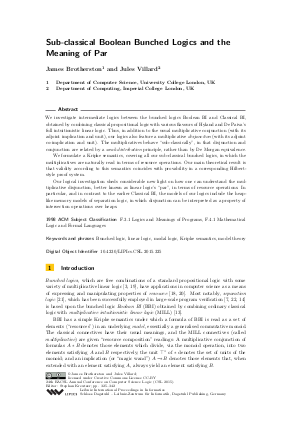Sub-classical Boolean Bunched Logics and the Meaning of Par
Authors James Brotherston, Jules Villard
-
Part of:
Volume:
24th EACSL Annual Conference on Computer Science Logic (CSL 2015)
Part of: Series: Leibniz International Proceedings in Informatics (LIPIcs)
Part of: Conference: Computer Science Logic (CSL) - License:
 Creative Commons Attribution 3.0 Unported license
Creative Commons Attribution 3.0 Unported license
- Publication Date: 2015-09-07
File

PDF
LIPIcs.CSL.2015.325.pdf
- Filesize: 0.5 MB
- 18 pages
Document Identifiers
Subject Classification
Keywords
- Bunched logic
- linear logic
- modal logic
- Kripke semantics
- model theory
Metrics
- Access Statistics
-
Total Accesses (updated on a weekly basis)
0Document
0Metadata
Abstract
We investigate intermediate logics between the bunched logics Boolean BI and Classical BI, obtained by combining classical propositional logic with various flavours of Hyland and De Paiva's full intuitionistic linear logic. Thus, in addition to the usual multiplicative conjunction (with its adjoint implication and unit), our logics also feature a multiplicative disjunction (with its adjoint co-implication and unit). The multiplicatives behave "sub-classically", in that disjunction and conjunction are related by a weak distribution principle, rather than by De Morgan equivalence. We formulate a Kripke semantics, covering all our sub-classical bunched logics, in which the multiplicatives are naturally read in terms of resource operations. Our main theoretical result is that validity according to this semantics coincides with provability in a corresponding Hilbert-style proof system. Our logical investigation sheds considerable new light on how one can understand the multiplicative disjunction, better known as linear logic's "par", in terms of resource operations. In particular, and in contrast to the earlier Classical BI, the models of our logics include the heap-like memory models of separation logic, in which disjunction can be interpreted as a property of intersection operations over heaps.
Cite As Get BibTex
James Brotherston and Jules Villard. Sub-classical Boolean Bunched Logics and the Meaning of Par. In 24th EACSL Annual Conference on Computer Science Logic (CSL 2015). Leibniz International Proceedings in Informatics (LIPIcs), Volume 41, pp. 325-342, Schloss Dagstuhl – Leibniz-Zentrum für Informatik (2015)
https://doi.org/10.4230/LIPIcs.CSL.2015.325
BibTex
@InProceedings{brotherston_et_al:LIPIcs.CSL.2015.325,
author = {Brotherston, James and Villard, Jules},
title = {{Sub-classical Boolean Bunched Logics and the Meaning of Par}},
booktitle = {24th EACSL Annual Conference on Computer Science Logic (CSL 2015)},
pages = {325--342},
series = {Leibniz International Proceedings in Informatics (LIPIcs)},
ISBN = {978-3-939897-90-3},
ISSN = {1868-8969},
year = {2015},
volume = {41},
editor = {Kreutzer, Stephan},
publisher = {Schloss Dagstuhl -- Leibniz-Zentrum f{\"u}r Informatik},
address = {Dagstuhl, Germany},
URL = {https://drops.dagstuhl.de/entities/document/10.4230/LIPIcs.CSL.2015.325},
URN = {urn:nbn:de:0030-drops-54234},
doi = {10.4230/LIPIcs.CSL.2015.325},
annote = {Keywords: Bunched logic, linear logic, modal logic, Kripke semantics, model theory}
}
Author Details
References
-
Nuel D. Belnap, Jr. Display logic. Journal of Philosophical Logic, 11:375-417, 1982.

-
Patrick Blackburn, Maarten de Rijke, and Yde Venema. Modal Logic. Cambridge University Press, 2001.

-
James Brotherston. Bunched logics displayed. Studia Logica, 100(6):1223-1254, 2012.

-
James Brotherston and Cristiano Calcagno. Classical BI: Its semantics and proof theory. Logical Methods in Computer Science, 6(3), 2010.

-
James Brotherston and Jules Villard. Bi-intuitionistic boolean bunched logic. Technical Report RN/14/06, University College London, 2014.

-
James Brotherston and Jules Villard. Parametric completeness for separation theories. In Proc. POPL-41, pages 453-464. ACM, 2014.

-
Cristiano Calcagno, Dino Distefano, Peter O'Hearn, and Hongseok Yang. Compositional shape analysis by means of bi-abduction. Journal of the ACM, 58(6), December 2011.

-
Cristiano Calcagno, Philippa Gardner, and Uri Zarfaty. Context logic as modal logic: Completeness and parametric inexpressivity. In Proc. POPL-34, pages 123-134. ACM, 2007.

-
Ranald Clouston, Jeremy Dawson, Rajeev Goré, and Alwen Tiu. Annotation-free sequent calculi for full intuitionistic linear logic. In Proc. CSL-22, pages 197-214. Dagstuhl, 2013.

-
Robert Dockins, Aquinas Hobor, and Andrew W. Appel. A fresh look at separation algebras and share accounting. In Proc. APLAS-7, pages 161-177. Springer, 2009.

-
Didier Galmiche and Dominique Larchey-Wendling. Expressivity properties of Boolean BI through relational models. In Proc. FSTTCS-26, pages 357-368. Springer, 2006.

-
Philippa Gardner, Sergio Maffeis, and Gareth David Smith. Towards a program logic for JavaScript. In Proc. POPL-39, pages 31-44, 2012.

-
Jean-Yves Girard and Yves Lafont. Linear logic and lazy computation. In Proc. TAPSOFT, pages 52-66. Springer-Verlag, 1987.

-
Alexey Gotsman, Byron Cook, Matthew Parkinson, and Viktor Vafeiadis. Proving that non-blocking algorithms don't block. In Proc. POPL-36, pages 16-28. ACM, 2009.

-
Aquinas Hobor and Jules Villard. The ramifications of sharing in data structures. In Proc. POPL-40, pages 523-536. ACM, 2013.

-
Martin Hyland and Valeria de Paiva. Full intuitionistic linear logic (extended abstract). Annals of Pure and Applied Logic, 64(3):273-–291, 1993.

-
Samin Ishtiaq and Peter W. O'Hearn. BI as an assertion language for mutable data structures. In Proc. POPL-28, pages 14-26. ACM, 2001.

-
Peter W. O'Hearn and David J. Pym. The logic of bunched implications. Bulletin of Symbolic Logic, 5(2):215-244, 1999.

-
David Pym. The Semantics and Proof Theory of the Logic of Bunched Implications. Applied Logic Series. Kluwer, 2002.

-
David Pym, Peter O'Hearn, and Hongseok Yang. Possible worlds and resources: The semantics of BI. Theor. Comp. Sci., 315(1):257-305, 2004.

-
John C. Reynolds. Separation logic: A logic for shared mutable data structures. In Proc. LICS-17, pages 55-74. IEEE, 2002.

-
H. Yang, O. Lee, J. Berdine, C. Calcagno, B. Cook, D. Distefano, and P. O'Hearn. Scalable shape analysis for systems code. In Proc. CAV-20, pages 385-398. Springer, 2008.

